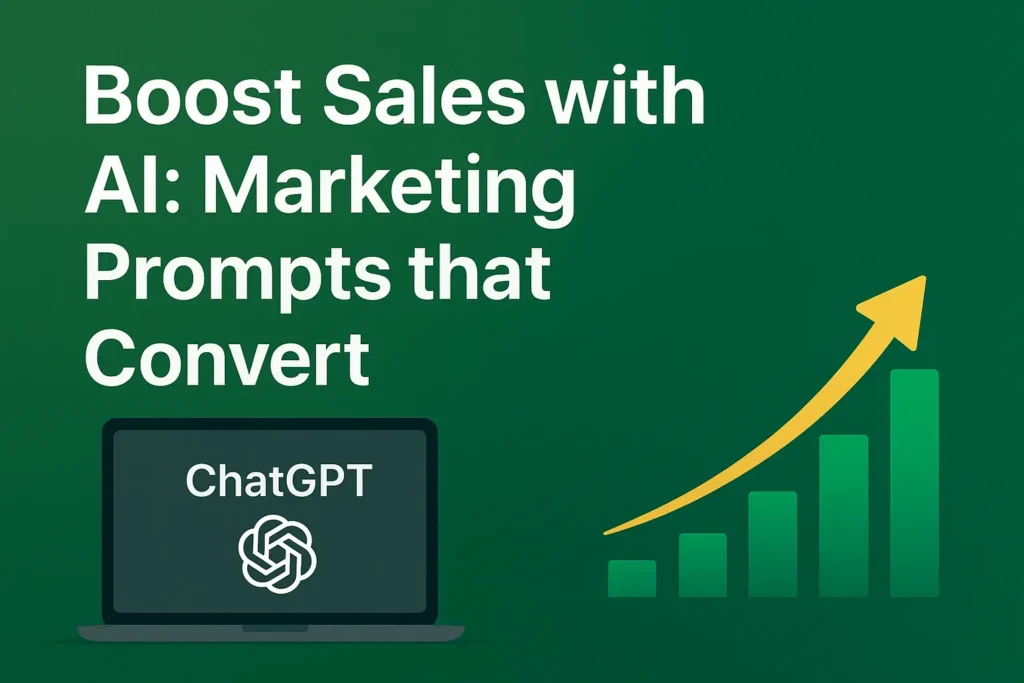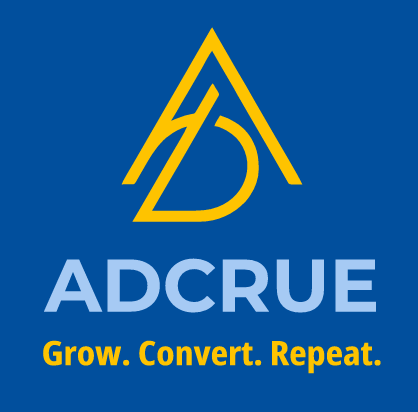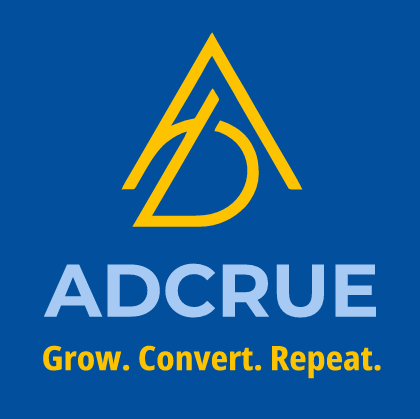15 Prompts to Create Better Content 10x Faster

Content marketing is eating alive businesses that can’t keep up. You know you need to publish consistently, create videos, write blog posts, engage on social media, and develop lead magnets. But there’s one massive problem: creating quality content is incredibly time-consuming.
Enter ChatGPT—the AI tool that’s fundamentally changing how marketers create content. But here’s what most people miss: ChatGPT is only as good as the prompts you give it. Generic prompts produce generic content. Specific, strategic prompts produce content that rivals—or surpasses—what human writers create.
At Adcrue, we’ve spent hundreds of hours testing, refining, and optimizing ChatGPT prompts for marketing. We’ve discovered the prompts that consistently deliver outstanding results, and today, we’re sharing exactly what works.
Why Most People Are Using ChatGPT Wrong
The typical approach to ChatGPT goes like this: “Write a blog post about [topic].” ChatGPT generates something generic. You publish it. It performs poorly. You conclude AI doesn’t work for content marketing.
The problem isn’t ChatGPT—it’s the prompt. When you give ChatGPT vague instructions, it produces vague content. When you provide detailed context, specify your goals, define your audience, and explain the desired outcome, ChatGPT becomes incredibly powerful.
Think of ChatGPT like a brilliant junior marketer on your team. If you just say “create marketing content,” they’ll struggle. But if you provide a detailed brief with audience insights, competitive context, strategic goals, and specific deliverables, they’ll create something remarkable.
The Anatomy of a High-Performance ChatGPT Prompt
Before we dive into specific prompts, understand the framework that makes prompts effective:
- Role Assignment: Tell ChatGPT who it should be (expert copywriter, SEO specialist, social media manager).
- Context: Provide relevant background about your business, audience, and goals.
- Specific Task: Clearly define what you want created.
- Constraints: Specify word count, tone, format, or requirements.
- Success Criteria: Explain what “good” looks like for this output.
Now, let’s dive into the 15 prompts that will transform your content marketing.
The 15 Game-Changing ChatGPT Marketing Prompts
Prompt 1: Strategic Blog Post Outline Creation
Why This Works: This prompt gives ChatGPT everything needed to create a strategic, SEO-optimized outline that serves as a roadmap for your writer. It’s not just a generic structure—it’s a competitive blueprint.
Adcrue Use Case: We use this prompt to create outlines for client blogs. It reduces our outline creation time from 90 minutes to 15 minutes, while often uncovering subtopics our team hadn’t initially considered.
Prompt 2: Audience-Specific Value Proposition
- Lead with the primary benefit (not features)
- Clearly differentiate from competitors
- Are specific and measurable where possible
- Create emotional resonance with the target audience
- Are under 20 words each
Why This Works: Most value propositions are feature-focused and generic. This prompt forces benefit-oriented, differentiated messaging that actually resonates with your audience.
Real Results: An Adcrue client struggled with messaging for their SaaS product. Using this prompt, we generated 5 value proposition options and tested them. The winning option increased landing page conversion rates from 2.4% to 7.1% in A/B testing.
Prompt 3: Social Media Content Calendar Generator
Why This Works: This prompt creates a diverse, strategic content calendar that keeps your social media active and engaging without repetitive content.
Adcrue Implementation: We use this monthly for clients, then have our creative team produce the actual content. It eliminates the “what should we post about?” paralysis and ensures strategic consistency.
Prompt 4: Email Subject Line A/B Test Generator
- Are under 50 characters (mobile-optimized)
- Include power words that drive opens
- Create curiosity or urgency where appropriate
- Avoid spam trigger words
- Are A/B test ready (distinctly different approaches)
Why This Works: Email subject lines make or break your campaign. This prompt creates diverse options based on proven psychological principles, giving you genuine A/B test candidates.
Performance Impact: We implemented this for a client’s weekly newsletter. Their average open rate increased from 19% to 34% by consistently testing ChatGPT-generated subject lines and implementing winners.
Prompt 5: SEO Meta Description Creator
Why This Works: Meta descriptions directly impact click-through rates from search results. This prompt creates optimized descriptions that stand out in SERPs and drive clicks.
Adcrue Data: We’ve found ChatGPT-generated meta descriptions (when properly prompted) consistently outperform human-written ones in A/B tests, likely because the AI can more objectively optimize for CTR triggers.
Prompt 6: Competitor Content Gap Analysis
- Topics they cover well (that we need to match)
- Topics they cover poorly (opportunities to do better)
- Questions they don’t answer (content gaps)
- Audience pain points they ignore
- Content formats they’re not using (video, infographics, tools, etc.)
Why This Works: This turns ChatGPT into a competitive intelligence tool, revealing opportunities your competitors have missed and exactly how to exploit them.
Client Success: A B2B client used this prompt to identify 12 content gaps in their industry. They created comprehensive resources filling those gaps and now rank on page 1 for 8 of those topics, generating 450+ qualified leads monthly.
Prompt 7: Persuasive Landing Page Copy
Why This Works: Landing page copy requires strategic structure and persuasive psychology. This prompt ensures all essential elements are present and properly positioned for maximum conversions.
Conversion Impact: An Adcrue e-commerce client’s landing page was converting at 1.8%. Using this prompt to restructure their copy (with our strategic input), conversion rate jumped to 6.4%—a 256% improvement.
Prompt 8: FAQ Content for SEO
- 15-20 questions people actually ask about this topic (include exact phrasing people use)
- Concise answers (50-80 words each) that:
Why This Works: FAQ sections are SEO goldmines, often ranking for dozens of long-tail keywords and capturing featured snippets. This prompt creates strategic FAQ content that serves users and search engines.
SEO Results: We implemented comprehensive FAQ sections using this prompt for a local service client. Within 60 days, they were ranking for 34 additional long-tail keywords they weren’t previously targeting, driving 280 extra monthly visitors.
Prompt 9: Video Script Creator
Why This Works: Video content requires different structure than written content. This prompt creates platform-specific scripts optimized for the way people consume video content.
Engagement Boost: An Adcrue client’s video content was getting 200-400 views. Using this prompt framework for their scripts (with our creative input), their average views jumped to 2,500-6,000, with much higher completion rates.
Prompt 10: Customer Testimonial Questions
- Start broad and get progressively specific
- Focus on transformation (before vs. after)
- Uncover specific, measurable results
- Identify emotional benefits (not just logical ones)
- Address common objections others might have
- Could produce quote-worthy responses
- Reveal the customer’s decision-making process
Why This Works: Generic testimonials like “Great company!” don’t convert. This prompt helps you gather specific, results-focused testimonials that address objections and build trust.
Conversion Impact: We implemented this for a consulting client. Their testimonials went from vague praise to specific results stories. Landing page conversion rates increased from 3.2% to 5.8% purely from better testimonial content.
Prompt 11: Content Repurposing Strategy
Why This Works: Generic testimonials like “Great company!” don’t convert. This prompt helps you gather specific, results-focused testimonials that address objections and build trust.
Conversion Impact: We implemented this for a consulting client. Their testimonials went from vague praise to specific results stories. Landing page conversion rates increased from 3.2% to 5.8% purely from better testimonial content.
Prompt 12: Ad Copy Variations Generator
- Fear of Missing Out (FOMO/Scarcity)
- Social Proof (testimonials, user numbers)
- Authority/Credibility
- Problem-Solution
- Curiosity Gap
- Direct Benefit
- Question-based
- Storytelling/Anecdote
- Comparison/Contrast
- Guarantee/Risk Reversal
Why This Works: Ad testing is essential for performance, but creating variations is time-consuming. This prompt generates diverse approaches based on proven psychological principles, ready for immediate testing.
ROI Impact: A client was running the same Facebook ad creative for months with declining performance. We used this prompt to generate 10 new variations, tested them, and the winning ad reduced their cost-per-acquisition by 64% while increasing conversion volume by 2.3x.
Prompt 13: Press Release Newsworthy Angle Finder
- 5-7 different newsworthy angles, including:
- For each angle, provide:
- Suggest 3-5 journalists or publications to pitch this to and why they’d be interested.
Why This Works: Getting press coverage requires framing your announcement in a way journalists and their audiences care about. This prompt finds angles you might miss on your own.
Media Success: An Adcrue client had a product launch but struggled to get media attention. Using this prompt, we identified 6 angles. The “local business creates jobs” angle landed them coverage in 3 regional publications and 1 national industry magazine, driving 12,000 visitors to their site in one week.
Prompt 14: LinkedIn Thought Leadership Post
Why This Works: LinkedIn’s algorithm favors posts that drive meaningful engagement. This prompt creates posts structured for maximum visibility and comment activity.
Engagement Results: Using this framework, Adcrue’s LinkedIn posts went from 50-200 impressions to 5,000-15,000 impressions, with 50-150 comments per post. Several posts went “LinkedIn viral” with 100,000+ impressions.
Prompt 15: Content Performance Improvement
- Content Audit:
- Improvement Recommendations:
- Content Expansion Strategy:
- Priority Action Plan:
Why This Works: Not all content needs to be new. Often, improving existing content delivers better ROI than creating new pieces. This prompt provides a systematic improvement roadmap.
Traffic Recovery: We used this for a client whose blog had 40 published posts but most generated minimal traffic. ChatGPT identified improvement opportunities for the top 15 posts. After implementing recommendations, those 15 posts increased traffic by 340% within 90 days.
How to Integrate ChatGPT into Your Marketing Workflow
Having great prompts is just the start. Here’s how to systematically integrate ChatGPT into your marketing process:
Step 1: Start with strategy, not execution. Use ChatGPT for brainstorming, research, and planning before jumping into content creation. Let it help you think through approaches before committing to a direction.
Step 2: Provide context liberally. The more information you give ChatGPT about your business, audience, and goals, the better its output. Save a “company context” document you can paste into prompts for consistency.
Step 3: Iterate and refine. ChatGPT’s first output is rarely perfect. Use follow-up prompts like “Make this more conversational,” “Add specific examples,” or “Emphasize the benefit more strongly.”
Step 4: Add human expertise. Always review, edit, and enhance AI-generated content with your unique insights, experiences, and brand voice. ChatGPT accelerates—it doesn’t replace—human creativity.
Step 5: Save your best prompts. When you create a prompt that consistently delivers great results, save it in a “prompt library” for easy reuse and team sharing.
Common ChatGPT Marketing Mistakes to Avoid
Using ChatGPT to fully write content without editing. AI-generated content lacks original insights, personal experiences, and authentic voice. Use it to accelerate, not replace, your content creation.
Not providing enough context. Generic prompts produce generic output. Take the extra 2-3 minutes to provide detailed context for dramatically better results.
Accepting the first output without iteration. ChatGPT improves with conversation. Ask follow-up questions, request alternatives, and refine the output.
Forgetting to fact-check. ChatGPT can be confidently wrong. Always verify facts, statistics, and claims before publishing.
Using ChatGPT for everything. AI excels at structure, ideation, and first drafts. It struggles with original research, brand voice consistency, and complex strategic thinking. Know where it adds value.
Advanced ChatGPT Marketing Techniques
Once you’ve mastered the basics, try these advanced approaches:
Create custom personas: Train ChatGPT to respond as your ideal customer, competitor, or industry expert. Use these personas for market research and messaging testing.
Build prompt chains: Use output from one prompt as input for the next, creating sophisticated workflows (research → outline → draft → optimization).
Use ChatGPT for A/B test generation: Generate multiple variations of headlines, CTAs, or ad copy for systematic testing.
Leverage for competitor analysis: Feed ChatGPT competitor content and ask for strategic analysis, gaps, and opportunities.
Create repeatable processes: Document your most effective prompt sequences to create repeatable content creation processes for your team.
The Future of AI in Marketing: What's Coming
AI tools like ChatGPT are evolving rapidly. Here’s what Adcrue is watching:
Multimodal AI: ChatGPT with image analysis capabilities means you can upload competitor ads, infographics, or website screenshots for analysis and optimization suggestions.
Real-time data integration: Future versions will access real-time search data, trends, and performance metrics for even more strategic recommendations.
Deeper personalization: AI will create custom content variations for different audience segments automatically.
Video and audio generation: AI-powered video and podcast creation will become mainstream, not just text.
Integrated marketing systems: AI will manage entire campaigns autonomously—from strategy to execution to optimization.
The marketers who embrace AI now and learn to use it effectively will have an enormous advantage as these capabilities expand.
ChatGPT and other AI tools are incredibly powerful, but they’re just that—tools. They don’t replace marketing strategy, customer insights, or creative thinking. They amplify it.
At Adcrue, we use AI to accelerate content creation, multiply our team’s output, and systematize what can be systematized—so we can focus more time on strategy, creativity, and results that matter.
The businesses winning with AI marketing aren’t the ones using it blindly. They’re the ones using it strategically, with clear goals and human expertise guiding the process.
Want to implement AI-powered content marketing that actually drives results? Contact Adcrue for a free content strategy consultation. We’ll show you exactly how to 10x your content output without sacrificing quality.

